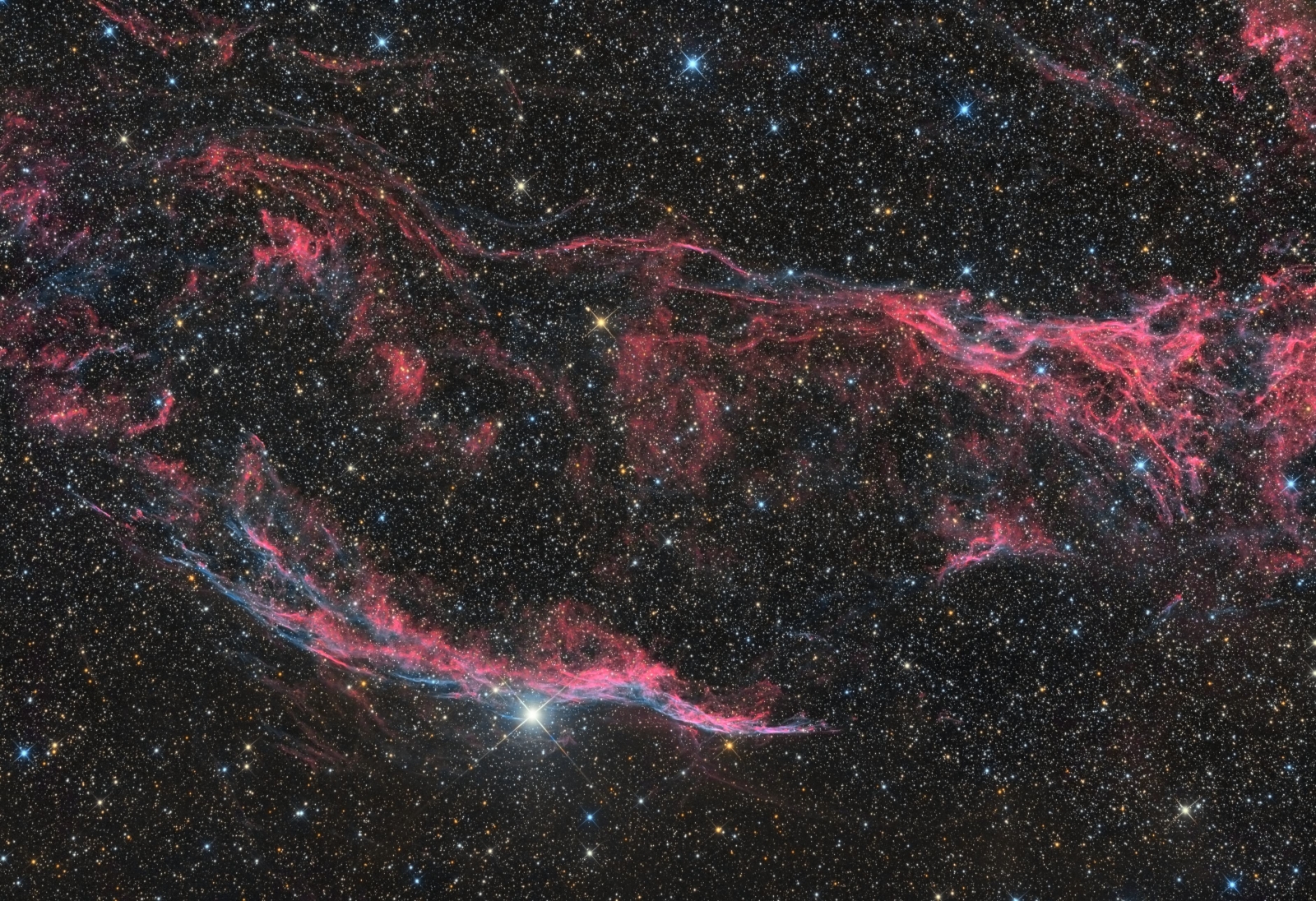NGC6960 and Pickering’s Triangle (2015)
Click image for full size version
January 24, 2015; Amateur Astronomy Picture of the Day March 22, 2015
[Click here for a more recent image that includes O3 data]
 The Veil Nebula complex is huge, covering about 7 moon widths on the sky, so I can’t get it all into one image. This image shows NGC6960 (sometimes called “The Witch’s Broom”) at lower left, Pickering’s triangle at right and through most of the centre, and a little bit of NGC6979 at upper right. All of these objects are part of a supernova remnant. You can find an image of the Eastern Veil Nebula here. A more complete image of NGC6979 is here. And a high resolution version of the broadest part of Pickering’s Triangle is here.
The Veil Nebula complex is huge, covering about 7 moon widths on the sky, so I can’t get it all into one image. This image shows NGC6960 (sometimes called “The Witch’s Broom”) at lower left, Pickering’s triangle at right and through most of the centre, and a little bit of NGC6979 at upper right. All of these objects are part of a supernova remnant. You can find an image of the Eastern Veil Nebula here. A more complete image of NGC6979 is here. And a high resolution version of the broadest part of Pickering’s Triangle is here.
The supernova that created the Veil Nebula happened between 5000-8000 years ago and the nebula has been expanding ever since. The glowing gas is mostly hydrogen and sulphur (red) and oxygen (teal) whose atoms are being excited by the pressure waves created by the massive supernova explosion. The progenitor star whose explosion created this object was about 1,470 light years away.
This image, acquired in the summer of 2012, began as a test shotafter some surgery on my telescope in the summer of 2012. A bare aluminum part inside the telescope focuser was causing some funny reflections inside the telescope. My wife, Gail, painted the offending part black. This required removing the focuser. After it was replaced I pointed at the Veil and took a test shot. I liked it and stayed there!
Tekkies:
SBIG STL-11000M camera, Baader LRGB filters, 10″ f/3.6 ASA astrograph, MI-250 mount. Guided with STL-11000’s internal guider. Focusing with FocusMax. Acquistion, guiding and calibration with Maxim-DL. All registration, integration and processing in PixInsight. Shot from my SkyShed in Guelph, Ontario. No moon. Above average transparency and average or below average seeing.
16x5m R, 15x5m G, 15x5m B and 12x20m Ha (total 7hr50m)
Synthetic Luminance:
Creation and cleanup: The R,G,B and Ha masters were combined using the ImageIntegration tool (average, additive with scaling, noise evaluation, iterative K-sigma / biweight midvariance, no pixel rejection). DBE was applied to neutralize the background.
Deconvolution: A star mask was made to use as a local deringing support. A copy of the image was stretched to use as a range mask. Deconvolution was applied (75 iterations, regularized Richardson-Lucy, external PSF made using DynamicPSF tool with about 40 stars).
Stretching: HistogramTransformation was applied using autostretch settings from ScreenTransferFunction.
Ha, R, G and B masters were cropped to remove edge artifacts from stacking. The R, G and B channels were combined to make an RGB image. Ha and RGB were processed with DBE, combined with the NB-RGB script, and Colour Calibration was applied. PixelMath was used to blend 3.5x RGB with HaRGB with rescaling. This was done to restore the teal regions of the object.
Combining SynthL with HaRGB:
The luminance was extracted from the HaRGB image, processed and then added back into the HaRGB image as follows:
1. Extract luminance from the HaRGB image.
2. Apply LinearFit using the SynthL channel as a reference.
3. Use ChannelCombination in the Lab mode to replace the luminance of the HaRGB with the fitted luminance from step 2.
4. Use LRGBCombine to appl SynthL to the HaRGB image.
Additional Processing
Noise Reduction and Re-Stretch: TGVDenoise was applied in RGB/K mode with 300 iterations with a range mask used to protect nebula and stars. This was followed by a HistogramTransformation to raise the black point (but with no clipping).
Star Reduction and Colour Adjustment: Morphological transformation (3×3, 3 iterations, strength 0.1) was applied using a star mask to protect background and nebula. Luminance was extracted from the image and LinearMultiscaleTransform was applied to extract the first 4 wavelet layers (no residual). This image was used as a mask when applying ColourSaturation to boost colour in the star cores.
Final Steps: A star mask was used to apply MorphologicalTransformation to the brightest stars (1 iteration; strength 0.51). A contrast adjustment and colour saturation tweak was applied. SCNR was applied to the background.
Image scale is about 2.2 arcsec per pixel for this camera / telescope combination.







Very nicely done, Ron! Love the deep Veil shots and yours is one of the best.